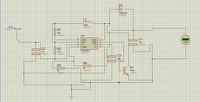sonar_abhi
Member level 1
Hello Guys,
I am facing a problem working with MC34063 under standard Boost configuration. Vin is 3.2V and Vout is 5V. Iout is 375mA.
When checked on a DMM, the Vout is 5V but if even a small load is applied, say a microcontroller, the voltage drops to 1.5V.
The component values are as follows:
Rsc: 0.22 ohms
R: 180 ohms
Cin: 10uF
Cout: 10uF
L: 22uH
R3:R4 (for 5V): 3.3K and 10Kohms
Diode: 1N5817
Can anybody please help?
Abhishek
I am facing a problem working with MC34063 under standard Boost configuration. Vin is 3.2V and Vout is 5V. Iout is 375mA.
When checked on a DMM, the Vout is 5V but if even a small load is applied, say a microcontroller, the voltage drops to 1.5V.
The component values are as follows:
Rsc: 0.22 ohms
R: 180 ohms
Cin: 10uF
Cout: 10uF
L: 22uH
R3:R4 (for 5V): 3.3K and 10Kohms
Diode: 1N5817
Can anybody please help?
Abhishek
